Technology
The Sports Facilities Companies Expands Ice Portfolio with 13 New Ice Properties and Two Community Centers
SFC assumes management of 15 facilities in 11 states through agreement with Rink Management Services CLEARWATER, Fla., May 22, 2025 /PRNewswire/ — The Sports Facilities Companies (SFC), the nation’s leading manager of sports, recreation, and event venues, has expanded its ice rink portfolio by assuming management of 13 ice rinks across 11 states, plus two […]
SFC assumes management of 15 facilities in 11 states through agreement with Rink Management Services
CLEARWATER, Fla., May 22, 2025 /PRNewswire/ — The Sports Facilities Companies (SFC), the nation’s leading manager of sports, recreation, and event venues, has expanded its ice rink portfolio by assuming management of 13 ice rinks across 11 states, plus two additional community centers. The facilities, previously operated by Rink Management Services (RMS), will now benefit from SFC’s expertise in operations, programming, and community engagement. Through the agreement, RMS operational leadership and staff will transition into the SFC network, enhancing its capacity to manage and elevate ice rinks nationwide.
“SFC continues to expand our presence as a leader in ice rink management, and this is an exciting step in that journey,” said Jason Clement, CEO of The Sports Facilities Companies. “RMS has built a strong footprint in the industry, and by integrating their experience with our proven approach to operations and community service, we are enhancing our ability to deliver exceptional outcomes for athletes, guests, and the communities we serve.”
Under the leadership of President Tom Hillgrove, RMS will maintain a small portfolio of leased agreements while SFC assumes management of the acquired facilities. Moving forward, the two companies will collaborate on strategic opportunities.
“We are excited to see these facilities transition to SFC, a company with a proven track record of success in community-focused facility management,” Hillgrove said. “RMS will continue to operate independently with our leased agreements while working alongside SFC to further strengthen the ice rink industry.”
SFC’s expanded portfolio of ice facilities and community centers now includes the following facilities:
-
Bryant Park Winter Village Ice Rink – New York, N.Y.
-
Lloyd Center Ice Rink – Portland, Ore.
-
Metro Park Toledo Glass City Ice & Roller – Toledo, Ohio
-
Wichita Ice Center – Wichita, Kan.
-
Parks Mall at Arlington – Arlington, Texas
-
Ice Skate USA Memorial City – Houston, Texas
-
Ice in Paradise – Goleta, Calif.
-
Breslow Ice Hockey Center – Lincoln, Neb.
-
Waconia Ice Arena – Waconia, Minn.
-
Industry City Ice Rink – New York, N.Y.
-
Elevance Health Rink at Bicentennial Plaza – Indianapolis, Ind.
-
Washington Harbour Ice Rink – Washington, D.C.
-
McCormick Tribune Ice Rink – Chicago, Ill.
As part of the deal, SFC will also take over management of multiple non-ice facilities, including the Romulus Athletic Center in Romulus, Michigan, and the Safari Island Community Center in Waconia, Minnesota.
Technology
Lottery.com Announces $10 Million Acquisition of GXR World Sports Assets
FORT WORTH, Texas, June 26, 2025 (GLOBE NEWSWIRE) — Lottery.com Inc. (NASDAQ: LTRY, LTRYW), a leading technology company transforming the intersection of gaming, sports and entertainment, today announced it is advancing its global expansion with the planned launch of the Sports.com Super App (the “Super App”)—a first-of-its-kind digital destination for sports fans worldwide. The Super […]
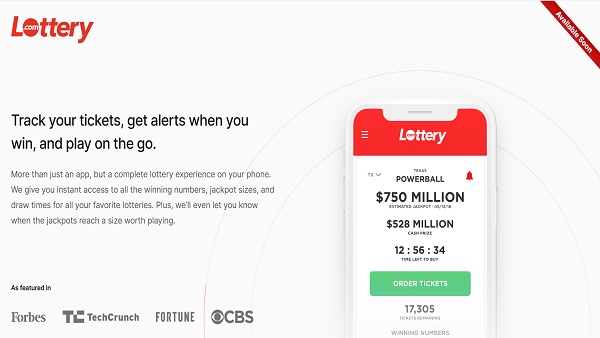

FORT WORTH, Texas, June 26, 2025 (GLOBE NEWSWIRE) — Lottery.com Inc. (NASDAQ: LTRY, LTRYW), a leading technology company transforming the intersection of gaming, sports and entertainment, today announced it is advancing its global expansion with the planned launch of the Sports.com Super App (the “Super App”)—a first-of-its-kind digital destination for sports fans worldwide. The Super App is designed to combine live streaming, social engagement, e-commerce and gamification into a single immersive ecosystem.
The Super App, which is scheduled to launch in select global markets in Q3 2025, will initially focus on soccer and motorsport—two verticals Sports.com has been aggressively expanding into through a series of high-profile sponsorships and strategic initiatives. The Super App will be built on an existing platform development by Galaxy Racer Holdings Limited (“GXR”), The GXR app has achieved more than one million monthly active subscribers organically, demonstrating significant early traction and category-defining potential.
“We’ve spent the past two years building Sports.com around key pillars like soccer and motorsport,” said Mark Bircham, Director of Sports.com. “This acquisition and the launch of the Sports.com Super App is the culmination of a precise strategy to consolidate fragmented sports experiences. Our partnerships with emerging motorsport stars like Callum Ilott, Louis Foster, and Sebastian Murray, along with this technology acquisition sets the stage for an aggressive media expansion that will redefine how fans watch, play and engage with their favorite leagues, teams, and players.”
The Super App will integrate six primary features into a single experience: live streaming, community chat hubs, stats-based social media, e-commerce, real-money and fantasy sports gaming, and sports news. The Super App aims to engage fans across the full lifecycle of the sports experience, tapping into the 4–5 hours of average fan interaction beyond match time each week.
Revenue streams will include premium streaming subscriptions, in-app advertising, merchandising and interactive gamified challenges. Plans are underway to extend into additional sports verticals and incorporate immersive streaming experiences later this year.
To accelerate the development timeline for the Super App, Lottery.com has signed a Letter of Intent (LOI) to acquire a 51% controlling interest in the sports and technology assets of GXR, valuing the transaction at $10 million pre-money. Subject to due diligence and final agreement, the deal allows Lottery.com to fund the $5.1 million initial investment via cash, stock, or a combination at a fixed $3.00 share price. A $15 million financing commitment has also been pledged by Lottery.com to fuel expansion of the Sports.com Super App.
All GXR unencumbered assets, including its tech stack and user base, will be transferred to a new entity (NewCo), of which Lottery.com will initially own 51%. The agreement includes a call option to acquire 100% ownership of NewCo by the end of 2027. Exclusivity has been secured through June 30, 2025, with an automatic 30-day extension, and closing is anticipated on or before August 1, 2025.
“This is a transformational moment for the worldwide sports media ecosystem,” said Paul Roy, Founder and CEO of GXR. “Together with Lottery.com and Sports.com, we are developing the world’s first true sports super app. As global licensing discussions advance, and integration with the Lottery.com family of brands begins, we see a future where fans control their entire live event experience—on the Super App, across all screens, in every corner of the globe.”
About Lottery.com
The Lottery.com Inc. (NASDAQ: LTRY, LTRYW) family of brands — including Sports.com, Tinbu and
Technology
Xiaomi launches its new budget tracker, the Xiaomi Smart Band 10
TL;DR Xiaomi has revealed all about the newly launched Xiaomi Smart Band 10. The device debuts with a 1.72-inch display, AI-powered fitness tracking, heart rate broadcasting, and deeper integration across Xiaomi’s ecosystem. Pricing for the Xiaomi Smart Band 10 starts at $49.90 in global markets. After weeks of leaks and speculation, Xiaomi has officially pulled […]


TL;DR
- Xiaomi has revealed all about the newly launched Xiaomi Smart Band 10.
- The device debuts with a 1.72-inch display, AI-powered fitness tracking, heart rate broadcasting, and deeper integration across Xiaomi’s ecosystem.
- Pricing for the Xiaomi Smart Band 10 starts at $49.90 in global markets.
After weeks of leaks and speculation, Xiaomi has officially pulled back the curtain on the Smart Band 10, the latest addition to its wildly popular fitness tracker lineup. The new wearable features key design tweaks, upgraded fitness tracking features, and deeper integration with Xiaomi’s growing ecosystem. Up front, the tenth-generation band boasts a larger 1.72-inch AMOLED display, thanks to narrower (and now symmetrical) bezels. Combined with the screen’s 1,500 nits peak brightness and a 60Hz refresh rate, that should translate to more vibrant visuals and smoother interactions.

According to the product page on Xiaomi’s website, the device is available in three metallic finishes of Midnight Black, Glacial Silver, and Mystic Rose, or as a premium ceramic edition in white. However, the company’s press release also mentions a green metallic option as well as additional ceramic variants. Regional availability may vary. All builds can be paired with a broad range of strap materials, ranging from fluororubber to leather to a knitted silk band. The tracking pill can also still be worn beyond the wrist, including on the new metallic pearl chain available for wearing the device as a pendant. Users can also personalize the device with a large selection of watch faces, including designs featuring mini-games.
The tracker retains the line’s design and can be paired with a variety of band materials or even worn beyond the wrist.
As far as fitness tracking capabilities are concerned, the band builds on its predecessors with a new 9-axis motion sensor, more than 150 workout modes, AI-powered training tools, and key upgrades in line with growing market trends. Users can expect personalized recovery plans and adaptive insights, swim stroke detection, on-wrist running guidance, and enhanced sleep detection. The Xiaomi Smart Band 10 is also the first in the series to support heart rate broadcasting, making it a more capable companion for serious athletes dependent on connected fitness apps.

For users already embedded in Xiaomi’s ecosystem, the Smart Band 10 also offers tighter device integration. From their wrists, users will be able to control a wide range of products, including everything from tablets to thermostats. Xiaomi also announced a modular desktop dock that can act as both a speaker and a smart alarm hub. Meanwhile, the band features a battery life claim of up to 21 days to provide plenty of usage between charges. With the always-on display enabled, that spec is cut down to 9 days.
Despite added features and a larger display, the Smart Band 10 still boasts up to 21 days of battery life.
The Xiaomi Smart Band 10 starts at $49.90 in global markets. Xiaomi says the wearable will be available in Europe, Latin America, the Middle East, Southeast Asia, and several other locales. For what it’s worth, the wearable costs 269 yuan (~$37) in China for the standard metal model, while the NFC-enabled version is priced at 319 yuan (~$44). The top-tier ceramic edition comes in at 379 yuan (~$52).
Technology
Valorant Masters 2025 Showcases Web3’s 50% Revenue Boost in Esports
The Valorant Masters 2025 tournament has achieved unprecedented milestones in the esports industry, attracting a massive audience and participation. The event showcased the latest advancements in Web3 technology, demonstrating the transformative potential of blockchain and decentralized platforms in competitive gaming. The integration of Web3 elements, such as non-fungible tokens (NFTs) and decentralized finance (DeFi), has […]
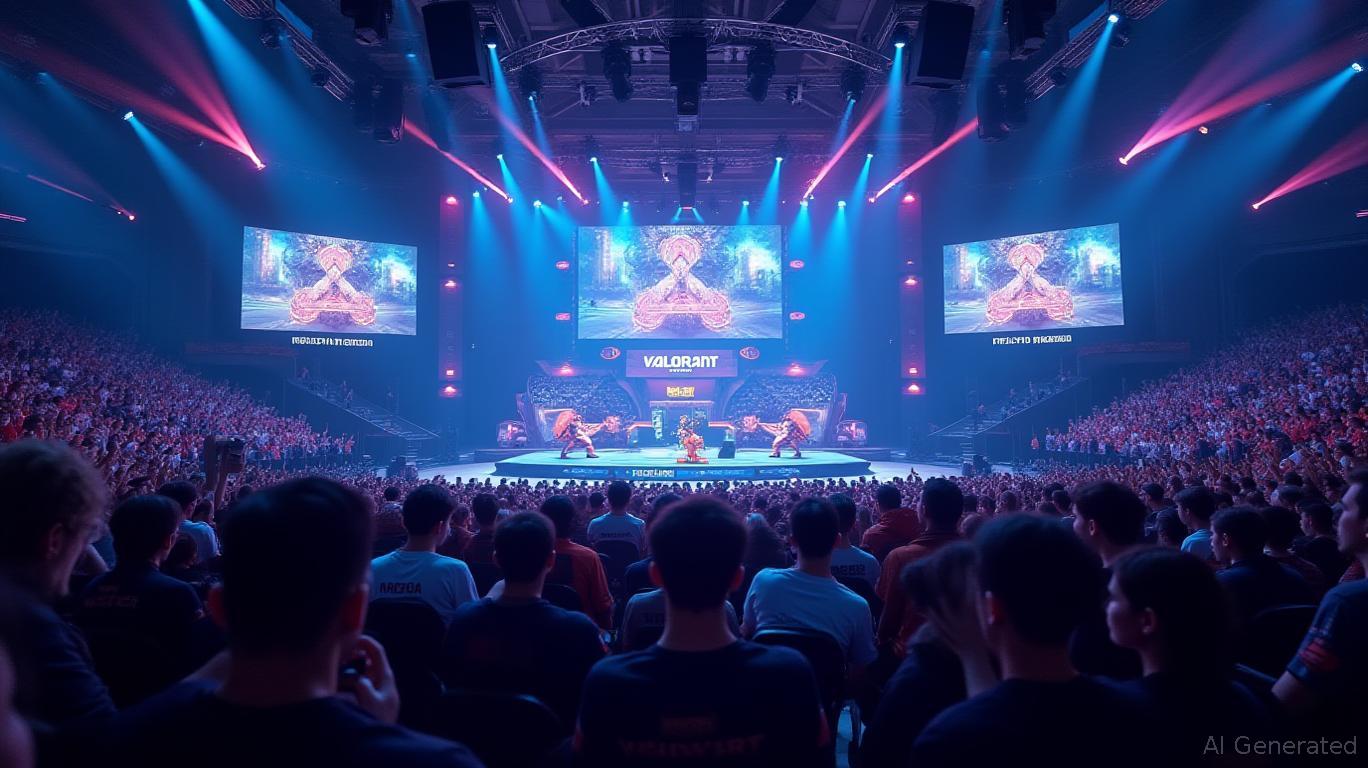
The Valorant Masters 2025 tournament has achieved unprecedented milestones in the esports industry, attracting a massive audience and participation. The event showcased the latest advancements in Web3 technology, demonstrating the transformative potential of blockchain and decentralized platforms in competitive gaming. The integration of Web3 elements, such as non-fungible tokens (NFTs) and decentralized finance (DeFi), has significantly enhanced the fan experience and opened new avenues for revenue generation and community engagement.
The tournament featured a diverse lineup of teams from around the world, each competing for the top spot in the competitive Valorant scene. The intense matches and strategic gameplay captivated audiences, with viewers tuning in from various regions to witness the action. The event’s success can be attributed to the seamless integration of Web3 technology, which allowed fans to engage with the tournament in innovative ways. For instance, fans could purchase exclusive NFTs, participate in DeFi staking pools, and even vote on in-game decisions, creating a more immersive and interactive experience.
The impact of Web3 on the esports industry is undeniable. By leveraging blockchain technology, esports organizations can create more transparent and secure ecosystems, ensuring fair play and protecting the interests of both players and fans. The decentralized nature of Web3 also enables greater community involvement, as fans can directly influence the direction of their favorite teams and tournaments. This shift towards a more decentralized model is expected to drive further innovation and growth in the esports sector, as organizations continue to explore the potential of Web3 technology.
The Valorant Masters 2025 tournament serves as a testament to the evolving landscape of esports, where technology and community engagement are at the forefront. As Web3 continues to shape the future of competitive gaming, it is clear that the industry is poised for significant growth and transformation. The success of this event underscores the importance of embracing new technologies and fostering a more inclusive and interactive fan experience. With the continued integration of Web3 elements, the esports industry is set to reach new heights, attracting a broader audience and creating more opportunities for players, teams, and fans alike.

Technology
Why are youth sports so expensive?
The U.S. has been the largest importer of sporting goods since 2010, accounting for 31% of the world’s imports in 2022. Youth sports are a big part of Karli Casamento’s life. Her son, Jax, 15, golfs and plays on three baseball teams. Her youngest son, Colt, 7, plays baseball and basketball. The costs, especially for […]

The U.S. has been the largest importer of sporting goods since 2010, accounting for 31% of the world’s imports in 2022.
Youth sports are a big part of Karli Casamento’s life. Her son, Jax, 15, golfs and plays on three baseball teams. Her youngest son, Colt, 7, plays baseball and basketball.
The costs, especially for Jax, add up in a hurry. That’s why Casamento, 48, and her husband, Michael, 46, are watching closely for the ramifications of tariffs on their rising youth sports budget.
“All of their equipment I’m sure comes from China,” said Karli Casamento, a second-grade teacher in suburban Philadelphia. “As they get bigger, they need new equipment. So that is definitely a concern.”
For families like the Casamentos and businesses in the marketplace, there is continued uncertainty surrounding the possible effects of President Donald Trump’s tariffs — the 10% baseline tariffs, along with a 30% rate on Chinese goods — on youth sports.
Nike, Adidas, Under Armour and Puma were among 76 companies that signed an April 29 letter to Trump asking for a footwear exemption from reciprocal tariffs. The Footwear Distributors & Retailers of America letter warned tariffs would “become a major impact at the cash register for every family.”
Amer Sports, the parent company of Wilson Sporting Goods and Louisville Slugger, downplayed the effect of tariffs when it announced its first-quarter earnings on May 20. But looking beyond this year, chief financial officer Andrew Page mentioned pricing as one way the company could offset higher import tariffs.
Dick’s Sporting Goods reaffirmed its earnings guidance for 2025 when it provided its first-quarter update on May 28. CEO Lauren Hobart said Dick’s had no plans to trim its product assortment in response to tariff costs, and that its guidance confirmation was based on its belief it can manage the situation.
“We are constantly assessing our pricing down to the item level, SKU level, and we do that based on consumer demand and the profitability of the business,” Hobart said in response to a question on possible price increases. “We have a very advanced pricing capability, much more advanced than we used to have, and much more enabled to make real time and quick decisions.”
Many of the US’s most popular sports rely on imported equipment
The U.S. has been the largest importer of sporting goods since 2010, accounting for 31% of the world’s imports in 2022, according to a 2024 World Trade Organization report. Boosted by racket sports, China is the most significant exporter of sporting goods at 43% in 2022.
Fueled by golf, badminton and tennis equipment, Vietnam and Taiwan experienced rapid expansion in exporting outdoor sports equipment to the U.S. from 2018 to 2024, according to data from the consulting firm, AlixPartners. Vietnam increased 340% to $705 million, and Taiwan was up 16% to $946 million.
Tariffs of 46% for Vietnam and 32% for Taiwan could go into effect next month after a 90-day pause.
Hockey skates, sticks and protective gear are often imported. Same for baseball gloves and composite and aluminum bats, which are often imported or use materials that are imported, according to the National Sporting Goods Association. Soccer goals, lacrosse nets and cones are often sourced from low-cost labor markets.
“You can’t get around the fact that a lot the stuff that we use in youth sports is coming from abroad,” said Travis Dorsch, the founding director of the Families in Sport Lab at Utah State University. “So surely if the tariffs go into effect and in any long-term or meaningful way, it’s going to affect youth sports.”
The Casamento family cheers for the Philadelphia Phillies, and that’s how Jax and Colt got into baseball. Karli Casamento called sports “a safe way to socialize, and it gets them active.”
But equipment has become a major expense for the family. Jax has a $400 bat and a $300 glove, Karli Casamento said, and his catching equipment is $700. There is an additional cost for registration for his travel team, in addition to what it costs to travel to tournaments.
“We’ve tried to say to Jax, ‘Well, you’re in ninth grade now, do you really need to play tournament ball? You’re not going to grow up and be, you know, the next Mike Schmidt,’ things like that,” Karli Casamento said, “because it’s just, it’s $5,000 a year and now we have two kids in sports.”
Tariffs may not impact all sports families equally
That effect most likely will be felt by middle- and low-income families, threatening recent gains in participation rates for youth sports.
The Sports & Fitness Industry Association, which tracks youth participation by sport, found in 2023 there was a 6% increase in young people who regularly participated in a team sport, which it said was the highest rate (39.8%) since 2015. An Aspen Institute study released in October showed participation for girls was at its highest levels since at least 2012.
“I’m really concerned that we’re going to spike this great momentum because families, who are already saying that sports is getting increasingly more expensive, equipment’s getting more expensive and they’re continuing to stretch to make that work, like this might be the one that just kind of puts them over the sidelines,” said Todd Smith, the president and CEO of the Sports & Fitness Industry Association.
Smith was in China in April for a World Federation of Sporting Good Industries board meeting. He visited some manufacturing facilities while he was in the country.
“The ones that I went to are really, really impressive,” Smith said. “First class, high tech, like highly skilled. And the thought that tariffs are all of a sudden just going to allow a 10-plus million dollar facility to just pop up the next day in the U.S. is just, it’s not feasible.”
Low-income families were already feeling a financial strain with youth sports before Trump was elected to a second term. According to the Aspen Institute study, 25.1% of children ages 6-17 from households earning under $25,000 played a sport on a regular basis in 2023, down slightly from 25.8% in 2022. That’s compared to 43.5% of children from households earning at least $100,000, up slightly from 42.7% in 2022.
Youth sports participation has a wide range of ramifications for public health, said Tom Farrey, the founder and executive director of the Aspen Institute’s Sports & Society Program.
“This incredibly virtuous cycle can be engaged if you can simply get kids off their phones and off their couches and into the game and they have a sustained experience into adolescence,” Farrey said. “And if you don’t, then you’re at risk for a range of health consequences, including obesity.”
Going along with playing on three baseball teams, Jax Casamento has workouts for his travel squad and also takes hitting lessons. The Casamentos turned a baseball trip to South Carolina into a family vacation last year.
Michael Casamento is a physical education teacher in an elementary school, so the family’s concerns about the effect of tariffs on the cost of youth sports go beyond their two boys.
“I work with a lot of kids that are a lower socio-economic status,” Karli Casamento said. “It really makes it harder for those types of families to be able to afford to play sports.”
Copyright 2025 Associated Press. All rights reserved. This material may not be published, broadcast, rewritten, or redistributed.
Technology
Xiaomi Smart Band 10 Review: The Best Budget Fitness Tracker, Again
At a glance Expert’s Rating Pros Stylish design Large, clear display Smooth software 5ATM waterproof Cons Mi Fit app feels a bit clunky in places Heart rate tracking not impeccable Ceramic edition pushes price up Our Verdict The Xiaomi Smart Band 10 cements its place as the best cheap fitness tracker with some nice upgrades, […]

Expert’s Rating
Pros
- Stylish design
- Large, clear display
- Smooth software
- 5ATM waterproof
Cons
- Mi Fit app feels a bit clunky in places
- Heart rate tracking not impeccable
- Ceramic edition pushes price up
Our Verdict
The Xiaomi Smart Band 10 cements its place as the best cheap fitness tracker with some nice upgrades, a new (pricier) look and a mix of features and performance that make it worthy of a place on your wrist.
Price When Reviewed
This value will show the geolocated pricing text for product undefined
Best Pricing Today
Price When Reviewed
Unavailable in the US
The Xiaomi Smart Band 10 arrives as the latest instalment in Xiaomi’s long-running fitness tracker band series, which once again wants to redefine your expectations of what a cheap fitness tracker can be and do.
For the Xiaomi Smart Band 9‘s successor, you can expect a larger AMOLED display, a new look and tracking sensors along with promised improvements to its onboard sports and sleep smarts.
Xiaomi has rarely put a foot wrong with its budget tracker, elevating the design and performance with every new edition. The Band 10 once again looks set to build on that good work to make the latest Band a tracker that continues to punch above its price tag of just £39.
Design & Build
- New ceramic case option
- Supports different wearing options
- Waterproof up to 50 metres
Xiaomi sticks largely to the same look as the Smart Band 9, matching up an aluminium case with a TPU strap and it’s now introduced a new ceramic finish case that’s partnered up with a fluororubber strap.

Mike Sawh
The non-ceramic version comes in black, silver or rose, while the ceramic version comes in pearl white. I can’t vouch for the look of the new model, but I can say that there’s nothing cheap-feeling about the standard model I’ve tested here.
The full colourways options are as follows:
- Midnight Black
- Glacier Silver
- Mystic Rose
- Ceramic Edition Pearl White
Both versions measure 10.95mm thick, so again, the same as the Band 9. They weigh less than 30g without the strap and even with the strap, this is a light tracker to wear and is very unobtrusive to take to bed as well.

Mike Sawh
Xiaomi lets you match up those cases with 11 optional band accessories and that includes a pendant option to let you wear it around your neck. Removing the straps is a breeze and is done by pressing two buttons on the back of each strap.
I was able to switch between living with the TPU band and one of the metallic link bracelet-style straps. I didn’t love the janky design of the metallic one, but it did at least offer a really nice solution to removing links to make it fit better. The TPU, while comfortable to wear, features one of my least favourite button clasp mechanisms that has on the odd occasion, got caught when taking off a t-shirt or jumper.

Mike Sawh
A 5ATM waterproof rating does make it safe to go swimming and to keep on in the shower. I’ve taken it for a dip in the pool and it’ll lock that screen before you get into swim tracking mode to prevent accidentally activating the display.
Screen & Audio
- Bigger AMOLED screen, thinner bezels
- Supports always-on mode
- No microphone or speaker included
The most notable design change lies with the screen where Xiaomi has moved from a 1.62-inch AMOLED display to a 1.72-inch, 212 x 520 one. That’s protected by 2.5D reinforced glass. Xiaomi says it’s also notched up the brightness, going from 1,200 nits to 1,500 nits.
growing the display helps to make features like displaying notifications feel a little less cramped

Mike Sawh
The display is supposedly surrounded by thinner bezels than the previous Band, though I’m not sure I could really tell a massive difference. What I could tell is that growing the display helps to make features like displaying notifications feel a little less cramped.
It is a nicely bright screen and you can adjust that brightness manually or leave the Band to do it automatically based on your conditions. You can keep the display on at all times too, with useful scheduled and smart modes available that display mode where it’s most relevant to do so and help keep battery life strong.
Unlike the Chinese version of the Band 10, a microphone and speaker remain missing in action for Xiaomi’s global model, which means missing out on being able to speak to Xiaomi’s Xiao assistant.
Software & Features
- Works with Android and iOS
- Offers music controls and over 200 watch faces
- Xiaomi smart home controls only for Xiaomi smartphones
The look and feel of Xiaomi’s HyperOS 2.0 really feels mostly identical to what we got on the Band 9. It’s a continuation of the good work Xiaomi has done to work on the Band’s slim screen.
The software runs smoothly and is a very easy operating system to get to grips with

Mike Sawh
Swipe from the main watch face in all directions and that is your way to get around. There are no physical buttons, so it’s all about taps, swipes and presses to navigate through menus and select items on screen.
The software runs smoothly and is a very easy operating system to get to grips with. The larger display gives widgets and text more room to spread out to help make things more glanceable.
While this is a fitness tracker first, it’s not enough these days to just focus on that.
While the small design does bring limitations on what Xiaomi can offer, it manages to squeeze in features like the ability to view notifications, weather forecasts, set up alarms, music controls and act a smartphone camera shutter.
A focus mode removes distractions like notifications buzzing, so you can fully concentrate on any important tasks.

Mike Sawh
If you own a Xiaomi smartphone and some Xiaomi smart home kit, you can use the Band to take control of those smart home devices.
What is here works well. The screen is always going to make it feel inferior to a larger smartwatch display for viewing phone notifications, but for features including the music controls and viewing weather updates, it’s perfectly fine.
I also think Xiaomi does a great job with the quality of watch faces it offers on the Band and how well optimised they are to that AMOLED display.
Some of these features need to be first enabled in the Mi Fitness app, which can be an arduous process at times. It’s also not one of the slickest companion apps available, either.
Fitness & Tracking
- 150+ sports modes
- Improved pool swim tracking
- Added heart rate broadcasting
Tracking your health and fitness is really what the Smart Band 10 is all about.
You won’t find medical-grade sensors or built-in GPS (again). What you do get is enough sensors, modes and insights that can make it more than useful to have on your wrist during workouts, sitting at your desk or when heading for bed.
Xiaomi has moved to a 9-axis motion sensor it says most notably improves swim tracking performance
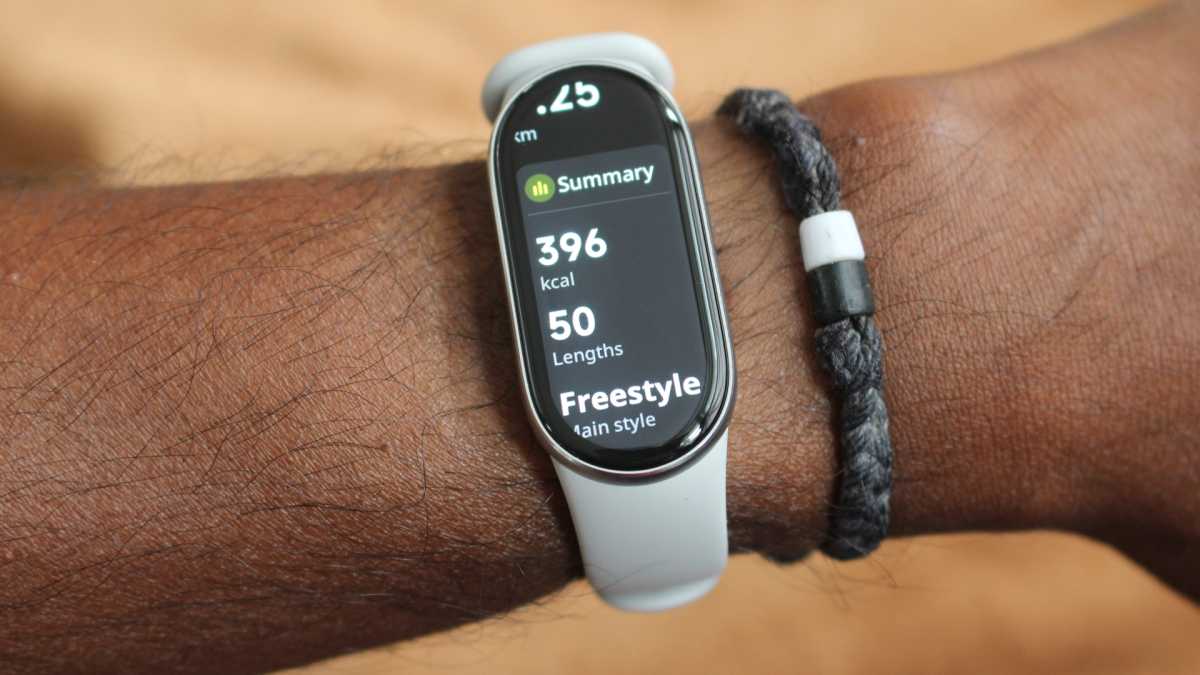
Mike Sawh
Sports tracking is an area where Xiaomi tries to improve the Band’s abilities. You still have connected GPS to use your phone’s GPS signal to track outdoor workouts. You’re also getting hundreds of sports profiles, including indoor ones like rowing and more niche ones like horse riding.
Xiaomi has moved to a 9-axis motion sensor it says most notably improves swim tracking performance and can offer a 96% lap count accuracy.
It now lets you broadcast heart rate data in real-time to other Bluetooth devices and this can be useful if you want to use it with a cycling computer or other connected equipment where you want to keep track of your effort.
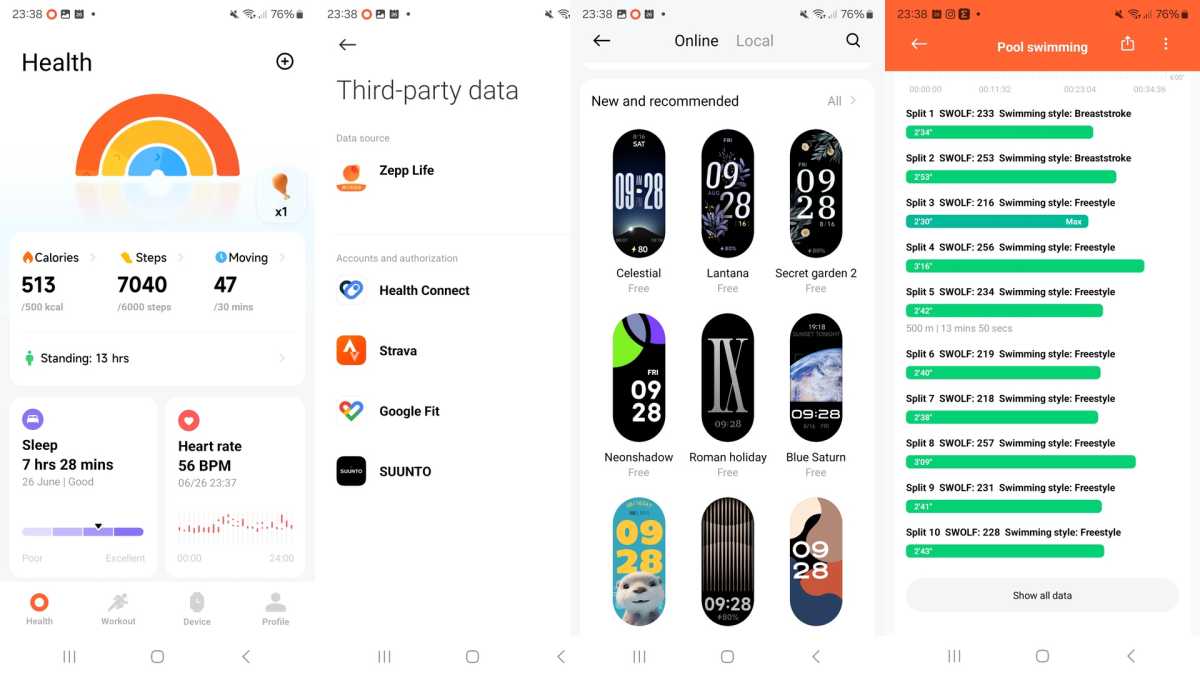
Mike Sawh
I used the Smart Band 10 in the pool against two other swim trackers and it was able to detect stroke type correctly in sessions where I started with breaststroke and then switched to freestyle. The distance tracking was a length out from the other trackers, while metrics like SWOLF scores and calories burned were similar.
The heart rate broadcasting is only useful if the heart rate sensor is reliable, and in my tests, it’s fared pretty well on the accuracy front. I’ve used it for runs, rows and indoor rides against the heart rate monitor chest strap and data like average readings and heart rate graphs were similar.
It did have a tendency to overreport maximum readings, however. It wasn’t massively off, but it was enough to question its reliability for higher intensity workouts.
There are plenty of additional sports watch-style metrics like VO2 Max estimates, as well as training load insights and recovery time recommendations. While I’d take them more as guidance rather than definitive advice, the delivery of the metrics on the watch is nicely done.

Mike Sawh
When you’re turning to the Band 10 to track daily steps, sleep, stress or keep tabs on your heart rate, it goes about its business in a pretty dependable way. I found step counts were typically around 500-600 steps in range of two other fitness trackers. For daily heart rate tracking, resting heart rate generally skewed higher against other devices, while average readings were typically higher as well.
Xiaomi offers its Vitality scores to provide added motivation to stay active over a week of tracking, but as I’ve said with previous Xiaomi devices, these scores need to feel more ingrained into the daily tracking process because right now, they’re too easy to ignore.
At night, you need to enable advanced sleep monitoring in the Xiaomi app to get a big fix of sleep data. The Band will assess your sleep quality, break down sleep stages, sleep efficiency and produce analysis and advice, which Xiaomi refers to as interpretation and suggestions.
For data like sleep duration and time fallen asleep, the Band 10 held up well against two other sleep trackers. For additional data like the attempts to analyse sleep, the presentation is a bit messy.
Battery Life & Charging
- Same battery capacity as Smart Band 9
- Up to 21 days battery life
- 9 days in always-on mode
Xiaomi sticks to the same 233mAh capacity battery used in the Smart Band 9 and that unsurprisingly leads to a similar battery performance. That’s up to 21 days, which drops to 9 days if you keep the screen on at all times.
It’s not an improvement on the Band 9, but it’s also not a drop in battery life either

Mike Sawh
I started my testing time using the Band 10 with the screen on at all times and the daily battery drop with some sports tracking on average was 10%. That roughly adds up to the promised 9 days.
Swap for the raise to wake mode and battery performance goes significantly further and will push closer to two weeks. That really does depend if you’re turning on everything the Band 10 is capable of, including its most advanced sleep and health tracking.
It’s not an improvement on the Band 9, but it’s also not a drop in battery life either. What’s more disappointing is that it once again uses a proprietary charging cable that clings to the back of the tracker’s case.
An hour going from 0-100% battery means you don’t have to keep it charged for long, at least.
Price & Availability
The Xiaomi Smart Band 10 was announced on 26th June 2025 in China, landing earlier than the Xioami Smart Band 9, which arrived in July 2024. The Smart Band 10 price in the UK sits at £39.99 for the standard version. That’s up from the Smart Band 9, which cost £34.99 at launch.
You can buy it from the official Mi store as well as retailers such as Amazon.
The new ceramic Smart Band 10 costs £54.99, making it the most expensive Smart Band, though it does come in cheaper than a Fitbit Inspire 3 still ($99.95/£85).
Xiaomi has not revealed US pricing for either version of its new Band.
That pricing does still make it very affordable and matches up with the pricing of the Huawei Band 9 (£49.99) and Amazfit Band 7 (£39.99).
Check out our list of the best fitness trackers to see more options.
Should you buy the Xiaomi Smart Band 10?
The Xiaomi Smart Band 10 is another Xiaomi fitness tracker that looks and feels great both in hardware and software and offers great value if you want something to keep tabs on your activity and general wellness.
If you own the Xiaomi Smart Band 9, then the main reason to upgrade is the larger display and the added 9-axis sensor. Adding a ceramic version brings a more refined option, though the Smart Band 9 does already offer a pretty customizable look. I still think the Band 9 is a great tracker and should hopefully get even cheaper now that the Band 10 has arrived.
It’s a more complete package than its closest budget rivals and shows that while the price has crept up, Xiaomi still reigns as the cheap fitness tracker champ.
Specs:
- 1.72-inch AMOLED display
- Up to 21 day battery life (same)
- Connected GPS
- 9-axis motion sensor
- Optical heart rate sensor
- Sleep and activity tracking
- 150+ sports modes
- 15.95g (without strap), 23.05g (ceramic edition without strap)
- Launch colours: Midnight Black, Glacier Silver, Mystic Rose, Ceramic Edition Pearl White
Technology
Affina’s managed services model sticks out for sports teams unable to fully on take on a fan loyalty program
CrowdPlay and Rethink Loyalty were speaking separately with the Boston Celtics about their fan engagement efforts in 2023 when a Celtics executive pointed out the two companies’ interlocking capabilities. The two sports fan engagement tech companies should merge instead of competing, the exec suggested. (Light bulb!) Within a year, the companies had merged, officially forming […]
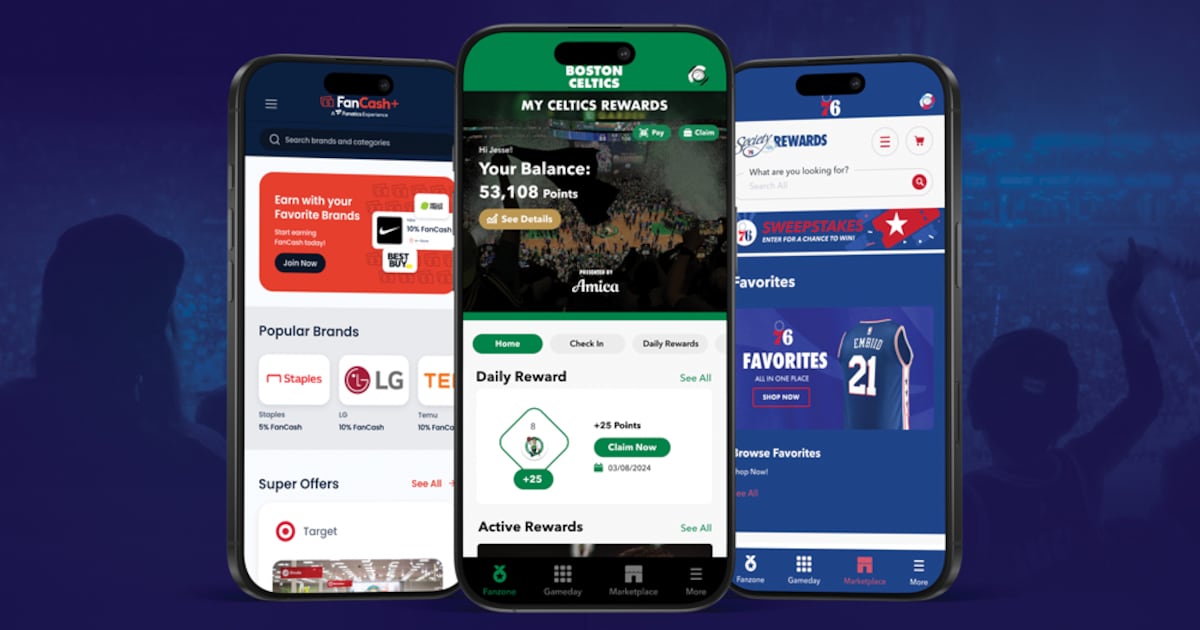
CrowdPlay and Rethink Loyalty were speaking separately with the Boston Celtics about their fan engagement efforts in 2023 when a Celtics executive pointed out the two companies’ interlocking capabilities. The two sports fan engagement tech companies should merge instead of competing, the exec suggested.
(Light bulb!)
Within a year, the companies had merged, officially forming Affina in December 2024. The timing was perfect. Many loyalty programs created during the 2010s withered on the vine, but rapid and widespread adoption of digital ticketing during COVID laid the foundation for the sports industry’s second crack at loyalty programs.
“Because you now have tech adoption mandated to some extent,” said PagsGroup associate Zach Yoshor, “That’s really what’s driving another look at how to incorporate better engagement tools into sports.”
Sports properties are approaching the fan loyalty program 2.0 era in different ways:
- Some are designing, building and running programs in-house.
- Others are doing some of the digital development and ongoing operations work in-house, but getting specific expertise from third parties.
- Many more sports organizations, lacking the resources or wherewithal to do any of that, are outsourcing much of the work and upkeep to a third party, such as Affina.
“We have two companies,” said Affina co-founder and CEO Andrew Pizzi. “[CrowdPlay] was expert in delivering loyalty solutions for sports teams and [Rethink] was expert in building card-linked and affiliate offer platforms. These are not features, they’re two businesses that came together to deliver a comprehensive solution for customers.”
The CrowdPlay portion of Affina’s business lets fans benefit from their fandom by earning rewards for all types of actions, whether completing a trivia quiz or scanning a QR code at a season-ticket members event. The Rethink Loyalty half of Affina provides the card-linked offers that help fund loyalty programs and generate revenue in a way sports loyalty programs didn’t in the past. Industry feedback led to the third leg of the Affina business, its managed services offering, in which the company operates sports properties’ loyalty programs once they’re built.
“That’s a part of the model that made a lot of sense,” said Next League Chief Digital Officer Shripal Shah. “Having dedicated attention to the loyalty touchpoints alone is going to see a higher [return on investment]. Them offering the managed services is why so many people are asking about them right now.”
Managed services quickly proved a differentiator for Affina in a fragmented field of competitors, helping the company double its sports client roster — which now includes Fanatics, a slew of NBA and NHL teams and an impending first NFL team — each year since 2021. The company has made the prospect of launching, maintaining and growing a fan loyalty program less daunting for sports properties, many of which were burnt in the past by loyalty program failure.
“When we first got into sports loyalty, it was a term that teams were scared of. They’d had bad experiences. Loyalty is at this point where it’s very hot, it’s about to really take off.”
— Andrew Pizzi, Affina co-founder and CEO
“I think the hard part was proving out the ROI and the lift was heavy, and it was just hard,” said Matt Griffin, Celtics senior vice president of strategy and business operations. “With companies like Affina, it’s easier to see that now.”
Affina recently closed a seven-figure Series A funding round with Yoshor and PagsGroup, the family investment office of Stephen Pagliuca, a former owner of the Celtics who knows sports team business operations. The company’s revenue has grown 307% in the past 12 months, though Pizzi couldn’t disclose revenue figures or whether the company was profitable. The business is non-capital intensive, and thanks to a timely, Celtics-inspired merger (and investment from its former owner), the Boston-based company is well positioned to take advantage of the fan loyalty renaissance in sports.
“When we first got into sports loyalty, it was a term that teams were scared of. They’d had bad experiences,” Pizzi said. “Loyalty is at this point where it’s very hot; it’s about to really take off.”
CrowdPlay, founded by Pizzi and Mike Cusano, originated as a gamification platform teams could use to engage fans, primarily in the minor league sports world.
The company had just raised a funding round in 2020 when COVID hit, eliminating crowds. Pizzi and Cusano pondered returning the investment, but ultimately sat on it for a year and a half. Because of the pandemic, they could get audiences with the pro sports teams that were previously too busy to meet. The duo listened to teams’ stories, cataloging the unfulfilled visions.
Repeatedly, teams said they had started a loyalty program led internally by a specific employee. Within a year or two, that employee would leave the job, and the program lost its pilot. That cycle would repeat again in another year or two.
What if CrowdPlay, in addition to providing the loyalty program product, could be the consistent shepherd of that program for the team, even through organizational change? Industry feedback was immediately positive.
“No one wants more tools,” Pizzi said, “they want solutions.”
Rethink Loyalty, led by Simon Goldstein, was building a business around the complex topic of CLO and arrived at the managed services model in a similar way. Major financial institutions, such as Chase or Visa, might have in-house card-linked offers expertise, but most companies, including relatively smaller ones such as sports teams, would not. By necessity, Rethink had to design, build and fully manage its solution.
Once the companies merged, the card-linked offer business became a key underpinning. Partnering with larger companies enabled Affina to amass roughly 80,000 card-linked offers, a huge offer pool for sports clients mostly clueless about creating such a library from scratch. Those offers effectively fund a team’s loyalty program.
“We were really the first company that white-labeled CLO to drive loyalty for teams and brands,” said Goldstein, Affina co-founder and chief innovation officer.
The card-linked offer business subsequently becomes a major data source for the sports property that can inform sponsorship and sales teams about their fans’ buying behaviors and habits. The Affina platform collects the data from fans’ card-linked shopping and makes it accessible to the team, which can use the information to source new sponsorship and sales leads (“Did you know 35% of our fans shop with you twice a month?”). Financial services company Plaid provides Affina clients with 24 months of historical spending data and all future spending data (regardless of where a fan’s card is used).
“Card-link offers can really drive a lot of insights around a fan persona,” said Shah. “From my experience, having a direct card link, because you can see real transactions, you can do better marketing.”
Fanatics initially wanted to become a merchant in Rethink Loyalty’s card-linked offers program. The sports merchandise juggernaut happened to have a significant pain point at that time: The average Fanatics customer was shopping with them only a few times per year. How often does a fan need a jersey?
That led Fanatics to become a Rethink customer. By folding in Rethink’s card-linking tech, Fanatics’ FanCash became more valuable to customers. That sparked a 2.8 times increase in spending frequency for Fanatics’ FanCash+ members compared to average customers, a 29% increase in average basket size and a 4.3 times increase in spending on Fanatics’ website.
“This was an opportunity to reward their customers everywhere else they shopped,” Goldstein said.
“You can be as involved or as little involved as is comfortable for you, as you want to. If you need a lot of hand holding, they’ll hold your hand.”
— Matt Griffin, Celtics senior vice president of strategy and business operations
When Rethink merged with CrowdPlay, the Fanatics relationship came along, too. That relationship appeals to clients such as the Celtics, whose Celtics Rewards points can be converted into FanCash and used on Fanatics’ platform. Affina and Fanatics handle fulfillment for team clients, sending gear directly to fans.
The New Jersey Devils’ three-year deal with Affina expired last summer, and the team went to the open market to study at least five other options. Affina’s managed services model set it apart and led to a new deal.
“There is a high level of trust,” said Zack Robinson, Devils vice president of ticket sales and service. “It’s huge because we don’t have a ton of bandwidth.”
Ditto for the Celtics, who couldn’t dedicate a full-time employee to their program, which launched last November with Affina. The Celtics, with huge ticket demand, limited the program to season-ticket holders. Membership sits in the low thousands. Their loyalty program choices are colored by not owning or operating TD Garden. The team is involved in Celtics Rewards, of course, but Affina handles the operations nitty-gritty, such as customer service.
“You can be as involved or as little involved as is comfortable for you, as you want to,” said Griffin. “If you need a lot of hand holding, they’ll hold your hand.”
Robinson first joined the Devils in 2017 and immediately scrapped the existing loyalty program he found. The challenge with the old program was “it was all on us,” he said. “I felt like I was hacking into an original Apple computer trying to set up the back end. We were kind of scarred.”
Robinson later launched the Devils’ Black and Red Rewards, partly to reinforce game attendance by offering rewards to season-ticket members who sell unused tickets back to the team. After its first season, the program was offered as a perk to season-ticket members who auto-renewed. Two-hundred ticket accounts chose it as an incentive. Several years later, 75% of the Devils’ season-ticket members are enrolled in Black and Red Rewards, with 70% using it daily. Eighty-five percent use it weekly, and 90% monthly. Trivia is one of the most popular engagement games, with 1.5 million questions answered this past season.
The Devils nominated Affina for an NHL Stanley Award in the Best Ticketing Initiative category. Based on the success, the Philadelphia 76ers, another Harris Blitzer Sports & Entertainment-owned team, rolled out a similar program with Affina last season. The next decision for the Devils is whether to expand Black and Red Rewards fan base-wide, and when.
“Are rewards a fad or does it have staying power? I get asked that all the time,” Robinson said. “Right now, the feedback is I think if you do it right, it does.”
-

 Motorsports2 weeks ago
Motorsports2 weeks agoNASCAR Weekend Preview: Autódromo Hermanos Rodríguez
-

 Motorsports2 weeks ago
Motorsports2 weeks agoNASCAR Through the Gears: Denny Hamlin has gas, a border needs crossing, and yes, that’s a Hemi
-

 High School Sports3 weeks ago
High School Sports3 weeks agoHighlights of the Tony Awards
-

 Motorsports2 weeks ago
Motorsports2 weeks agoNASCAR Race Today: Mexico City start times, schedule and how to watch live on TV
-

 Health2 weeks ago
Health2 weeks agoGymnast MyKayla Skinner Claims Simone Biles 'Belittled and Ostracized' Her amid Riley …
-

 Professional Sports3 weeks ago
Professional Sports3 weeks agoUFC 316
-

 Sports2 weeks ago
Sports2 weeks agoCoco Gauff, The World's Highest
-

 NIL2 weeks ago
NIL2 weeks agoTennessee law supersedes NCAA eligibility rule
-

 College Sports3 weeks ago
College Sports3 weeks agoFisk to discontinue history-making gymnastics program after 2026 | Area colleges
-

 Social Media2 weeks ago
Social Media2 weeks agoPune Athletes Make Global Mark at IRONMAN Hamburg and Brazil 2025














 For The WIN | #NBATogetherLive Classic Game
For The WIN | #NBATogetherLive Classic Game





















